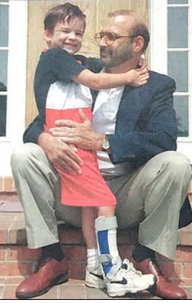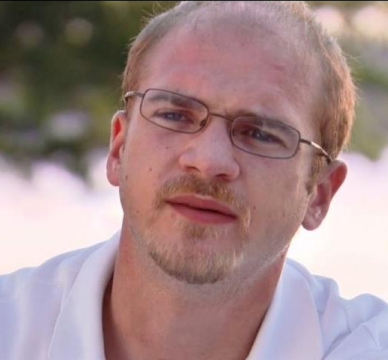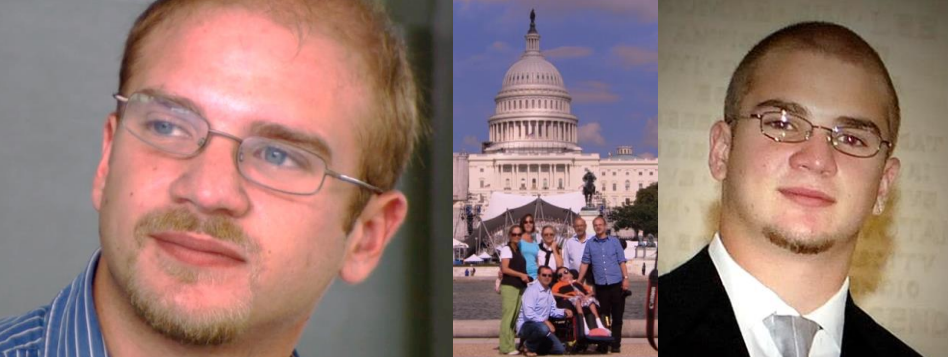David Salamone: He Did Something Good… and his Life Made a Difference
Telling David’s Story. Updated from the original published in 2020 by John Salamone
Today my six-year-old son, David, started karate*. To most parents, such an occasion would be one of many proud events in the growth of their child; however, for my wife, Kathy, and me it was much more. Only five years ago, David contracted polio and we thought he might never walk.
It was in the fall of 1990 when we, like millions of other parents, brought our seemingly healthy baby to the pediatrician for his routine vaccinations.
David cried as the doctor and nurses administered his shots and oral vaccination. The memory of that cry still haunts me, as I now realize what we brought upon David that day.
Within 48 hours David had a high fever and rash, and, within weeks, our active baby boy could no longer use his legs to crawl. Our son had contracted polio from the vaccine that was supposed to protect him. (We later learned that David was born with a genetic disorder known as Brutons agammaglobulinemm, which left him with only a limited immune system and made him vulnerable to the limited immune system and made him vulnerable to the small amount of the live virus in the polio vaccine he had been given.)
Disbelief Turns To Anger
Kathy and I felt a myriad of emotions when we realized David had contracted this dreaded disease, which only 40 years ago had afflicted millions. Our disbelief quickly fumed to fear as we looked ahead to an uncertain future for our only son. We also felt guilty, since by providing for David's vaccinations we had unwittingly participated in making him a victim of polio. But we were also angry, and the more we realized, the angrier we became. Why didn't our doctors tell us about potential risks and options? We finally decided to channel our anger into a crusade to ensure that other children would not suffer the same fate.
I began to research the U.S. polio immunization program. I was especially interested in comparing the original Salk vaccine to the Sabin vaccine developed several years later. Both vaccines share the credit for the virtual eradication of polio in the United States. However, the Sabin vaccine became the vaccine of choice for several reasons: 1) it was orally administered (the Salk vaccine needed to be injected); 2) it was believed that this "live" vaccine would be more effective than Salk's "killed" vaccine; and 3) the Sabin vaccine was less expensive to produce. For the sake of an easy-to administer and cost-effective universal vaccination program, the government decided to promote the oral Sabin vaccine, even though it was known that a small number of children each year would actually contract polio from it.
Telling Our Story
I began a letter-writing campaign in earnest. I wrote letters to the Centers for Disease Control and Prevention (CDC), to individual members of a working group that had been established to explore possible changes in our national vaccine program, to members of Congress and even to President Clinton. I talked to the National Vaccine Information Center (NVIC) to share our experience and ask for any information or help they could provide. Finally, thinking I could take my case directly to the people, I also sent dozens of letters to medical reporters across the country. My message was simple: Since wild polio has not existed in the United States for nearly 20 years, isn't it time that the government began to encourage the use of the effective and safe killed polio vaccine to prevent more victims like David?
For several years, it seemed no one was interested in our story. Finally, in June 1995, the NVIC (National Vaccine Information Center) asked me to appear before a CDC committee at a conference in Washington, where I and other parents would testify about our experiences with vaccinations that had caused disabilities. After four years, I finally had the chance to tell the stories of David and the more than 100 other children who had contracted polio from a live vaccine over the past 10 years.
I knew that this was my one chance to be heard and that I had to present the most persuasive case possible for changing the polio vaccine program. As vividly as possible, I described David's daily struggles and physical therapy. I told of our sadness as we watched him try to keep up with other children at the playground, and I explained how other industrialized countries had already changed to a killed vaccine program, with no cases of vaccine-related polio in decades.
A few reporters attended the meeting, and within days there was a newfound interest in David's story. The Washington Post wrote an article about my testimony, followed by a six-page cover story in their Health section. The Associated Press ran a wire story and photograph of David. USA Today decided to do a feature on David, and the television program Inside Edition devoted an entire segment to his story. One day, my wife called me at work because a CNN film crew had just appeared at our door. The NVIC received more than 20,000 telephone calls as a result of the coverage.
One Voice Can Make a Difference
In October 1995, the CDC proposed the first changes in the polio vaccine program guidelines in more than 30 years. They could no longer justify that the only cases of polio in the United States each year were those contracted as a direct result of the oral polio vaccine. The proposed guidelines provide that the first two childhood polio immunizations use the killed vaccine delivered by injection and seem to imply that the ultimate goal would be the eventual elimination of the live oral polio vaccine.
One month after this decision, the Secretary of Health and Human Services asked me to serve on the Advisory Commission for Childhood Vaccines. I accepted with the hope that one voice can still make a difference. I will need that voice, since the manufacturers of the oral polio vaccine are taking legal action against the newly proposed CDC guidelines, which are scheduled to go into effect later this year
A Story of Hope
David is now in first grade*. It sometimes seems that he spends more time with doctors than with other children. With the help of a leg brace he can walk, but he tires easily. He calls his physical therapist the "toy doctor" because of the playthings used in his therapy sessions. He has no special names for the other doctors--neurologists, physiatrists, rheumatologists and orthopedists--who have become a regular part of his life. He will live with infusions of gammaglobulin every four weeks and daily doses of antibiotics for the rest of his life. He has also been left with arthritis and pulmonary deficiency.
Despite these challenges, David's story is a story of hope, not despair. Nothing keeps him from doing the things other kids do. Last year, we took him skiing and he couldn't wait to hit the slopes.
During the Blizzard of 96, David rallied our neighborhood kids for sledding and building snow forts. He recently told my wife, Kathy, that he wants to take gymnastics like his sister Liz. Why not?
I am not sure David will ever become a black belt in karate, but I do know he will try. As he gets older, I hope he will realize that he has achieved much more--he helped to ensure that hundreds of children from his generation will not be crippled by polio.” (1)
The Long Road Ahead - Where They Went From Here
“We desperately wanted a safer polio vaccine, but we knew we could not get it with just press and politicians. We made our case to the media and the Congress, we now needed to focus on the decision-makers and work within the system at the CDC. It was time to go to Atlanta. I researched and discovered dozens of other VAPP families throughout the United States. We shared our stories and our pain. I convinced many of them to join us at a meeting of ACIP in June of 1996. It was clearly a turning point. I think we spoke to the hearts and minds of the ACIP members.” (2)
“John knew he had to capitalize on the momentum he had created. How to do that?” “ACIP meetings are open to the public, so getting in was no problem. But the committee members had never seen anything like what met their eyes that day. A dozen families with VAPP victims in wheelchairs, on crutches, and in braces rolled into the meeting. The members of the committee knew the purpose of their presence without being told. They occupied the meeting room, watching and waiting for their turn to have their stories told. John would be their primary spokesman.”
“John Salamone is a friendly guy. ‘I can tell you right now that I paid for my way here. Every one of these families and their children in wheelchairs paid their way here. All that I ask is that before anyone testifies before this committee, that you ask them, Did you pay for your own trip here? Did anyone reimburse you for expenses related to your testimony here today?’ I said, ‘Just do me that favor.’ ” And they did.
“We had nothing financially to gain here. Our kids were already impacted. Our only interest, our only concern, was for the next kid. It was too late for us.” ** (3)
For the first time they saw the faces and braces behind the statistics. “As I was testifying, I looked down at these members and I could’ve sworn I saw tears in a couple of eyes. I mean, they really got it. It also helped those kids, and especially my David, feel they could make a difference and help others - their sacrifice was not in vain.”
While it took several more years, ACIP transitioned to an all-IPV schedule in 2000, and since that date, there have been no cases of Vaccine Associated Paralytic Polio in the US. David did good and he helped. We are grateful to the CDC for recognizing his contributions and those of others, for a safer US immunization program.” (2)
A Father’s Reflection
“I learned several things from this experience. I learned the professionals who work at the CDC, and who serve on important committees like ACIP, are dedicated, intelligent, and caring individuals who take seriously their responsibility to create a world where people are not injured or die from preventable diseases. Because of your work, many of those diseases, such as smallpox, measles, rubella, tetanus, diphtheria, and, of course polio, have been virtually eradicated in the US. And today, the CDC and ACIP are on the front lines of protecting Americans from growing concerns of coronavirus.
“You (the CDC) have saved too many lives to count, and I am grateful to you and the decisions you made based on science, and not rumors and unwarranted fears.
I wish David were here to celebrate more than 25 years of a VAPP free America. David passed away on September 7, 2018. On his last ambulance ride to Georgetown Hospital he said to his mom, ‘I just want to do something good for people - I know I can help.’ We can now truly say since the year 2000 polio has been eradicated in the United States.” David did good. I hope you agree.” (2)(3)
“By age 3, after endless tests, his doctor got back to us. Your son has a genetic disorder. He was born without half his immune system*.” “In retrospect, that explains why he kept getting sick.” “No one knew he had a compromised immune system when we gave him the live polio vaccine that day.”
“No doctor we saw had ever seen a case of polio.” “Our anger turned into action.” John Salamone.
Brutens Disease means his body cannot produce anti-bodies. When a germ enters his system, he has no way to mount a defense.
“It seems to me that we can’t be guided by bad science. It would be reckless to go out there and attribute certain side effects to a vaccine when they’re not documented by science. Attacking vaccines with bad science and bad information is nothing short of reckless and irresponsible.” John Salamone (4)
“John Salamone had every reason to question doctors. John Salamone didn’t see doctors as evil. Rather, he believed he could convince them that choosing Sabin’s vaccine over Salk’s was illogical and dangerous. He believed that he could appeal to their ability to reason – that they were human and would respond humanely. And he was right. Salamone’s rational advocacy earned the respect of doctors and policy makers.” Paul A. Offit, MD. (4)
“People would think that we would come out anti-vaccine, but we aren’t. We’ve seen the devastation of what a childhood disease can do.” Susan Pierson (5)
“I’m not against vaccinations. I’m pro vaccination. We had thousands of people contacting polio prior to the vaccination. We came out with the vaccine and that number decreased significantly. So less people are getting sick, less people are affected. That’s a good thing, regardless of any way you look at it.” - David Salamone
Watch: Vale David Salamone - A video of David’s life by Genepool Productions.
Footnotes:
(1) Telling David's Story: One Father's Fight to Increase the Safety of Childhood Immunizations By John Salamone | The Exceptional Parent, August 1996
(2) ACIP REMARKS – By John Salamone, February 27, 2020
(3) The David Salamone Story – By John Salamone 2019
(4) Deadly Choices: How the Anti-Vaccine Movement Threatens Us All By Dr. Paul Offit, MD
(5) Vale David Salamone – Genepool Productions David Salamone
NOTE: All photos used with permission from John Salamone.
This story cannot be reproduced without permission from the Polio Network






